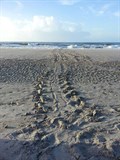
When do sea turtles nest here? May 1 through the end of August is Topsail’s official nesting season. Usually we see the first verified nest about mid-May, and sometimes it’s even on Mother’s Day! Although most mamas are done nesting by the end of August there’s an occasional outlier who makes her last visit early in September.
How do you know that a turtle has nested? Our volunteers are trained to look for turtle tracks which are very distinctive. If they see signs of nesting they work with their area coordinator in verifying that a nest has actually been laid. Not all tracks lead to a nest, what we call a “false crawl.” Mom may have decided that the sand wasn’t to her liking, or she may have been disturbed and headed back to the ocean before laying. If you see what looks almost like tank tracks coming out of the ocean toward the dunes and then heading back you’ve most likely seen at least an attempt at nesting.
When can we watch them nesting? Instinctively the moms come sometime after dusk and complete the process before dawn. It’s not easy to drag a three or four-hundred-pound body designed for ocean living onto shore and up to the dune lines, the optimal place for a nest. Turtles don’t check their calendars and Rolexes, and they’ve out-lived the dinosaurs by being smart enough to know when there’s the least chance of human or predatory dangers. If you see a nesting turtle consider yourself lucky.
Do they really come back to the beach where they were born to nest? For years that was the common turtle lore, but based on a continuing research project being done at the University of Georgia it seems that picking a nesting spot is more a matter of where you happen to be when the urge strikes. And who knows where a turtle was really born anyway! Our northern loggerheads do not reach nesting age until they’re about thirty-five, and they’ve put a lot of miles on those flippers by then. We have been participating in the Georgia project that tracks individual turtles by submitting one egg from each nest for mitochondrial DNA analysis. The data is fascinating as it tells exactly where and how often a particular turtle nests in any given year. It even tells us who’s related: mothers, daughters, sisters and aunts. We are family!
How often do sea turtles nest? Again, we’re getting a better picture of sea turtle habits based on the same study. And again, turtles are like humans in that some want big families and some think small. There’s no way to predict exactly how often mom will lay a clutch of eggs, and it may vary during her lifetime based on so many things. Generally a nesting female will lay at least twice during the season, and if she likes the sand and the environment of the first nest she may lay the second in the same general area.
How many eggs are in a nest and how long does it take to lay them? Nesting’s tough. After selecting the perfect spot mom will use her rear flippers to scoop sand out to a depth of almost two feet. Then she’ll position herself over the nesting chamber and proceed to lay an average of about 120 eggs, after which she’ll top off the nest with sand and pat it down firmly. One last thing before leaving; she’ll use her flippers to fling sand around the area in order to disguise her work. The process takes about an hour and a half and any disturbance could cause her to abandon the nest and return to the ocean where she may lose her eggs due to stress. Never, never disturb a sea turtle you see on the beach as she may be headed for a nesting spot or just trying to get home after a very long night on the job. And, it’s very unlikely that mom and her kids will ever meet during their lifetime.
What kinds of turtles nest here? Topsail is loggerhead territory, and by far that’s the species that lays the most nests here. But we’ve seen an increase of green activity and last year we had our first verified Kemp’s. We’re hoping that maybe this year a leatherback mama will give Topsail another “first.”
Are there any ways we can help nesting sea turtles? Yes: first of all, remember to never disturb a nesting turtle in any way. It’s not only harmful to the turtle it’s illegal under the Endangered Species Act and will result in heavy fines. That means you should never approach or follow mom, and keep pets away. And no flashlights on her, or flash photos, especially “selfies.” Just remember how that poor baby dolphin died after a beach crowd passed it around for hours taking selfies! If you’re staying (or live) at the beach turn outside lights off beginning now. It’s distracting and could cause an exhausted mama to head toward the house (or even the road!) instead of back to the ocean. And it should be common sense that if you dig a hole in the sand fill it in before you leave for the day. There are ordinances in the towns and if you’re caught leaving a crater that could trap and injure a human or turtle you’ll be cited. Same thing with other “beach things” like chairs, plastic toys and canopies. Turtles don’t see that well out of the water, and add in darkness and their focus on their mission and they can easily get tangled and injured in the debris. Plastic in the ocean is bad enough, let’s try to keep it off the beaches for all of our sakes.
What do I do if I see a nesting turtle and nobody is around? Even with all the coverage by our Topsail Turtle Project volunteers it’s possible to miss nesting signs for a variety of reasons. That’s why we ask you to be our extra eyes and to report any tracks to our Director of Beach Operations, Terry Meyer at: 910-470-2880; Hospital Director, Jean Beasley at: 910-470-2800 or the State of NC hotline for stranded, sick and injured turtles at: 252-241-7367. The state number picks up 24/7.
Written by Karen Sota, Communications volunteer with the Karen Beasley Sea Turtle Rescue and Rehabilatation Center.



